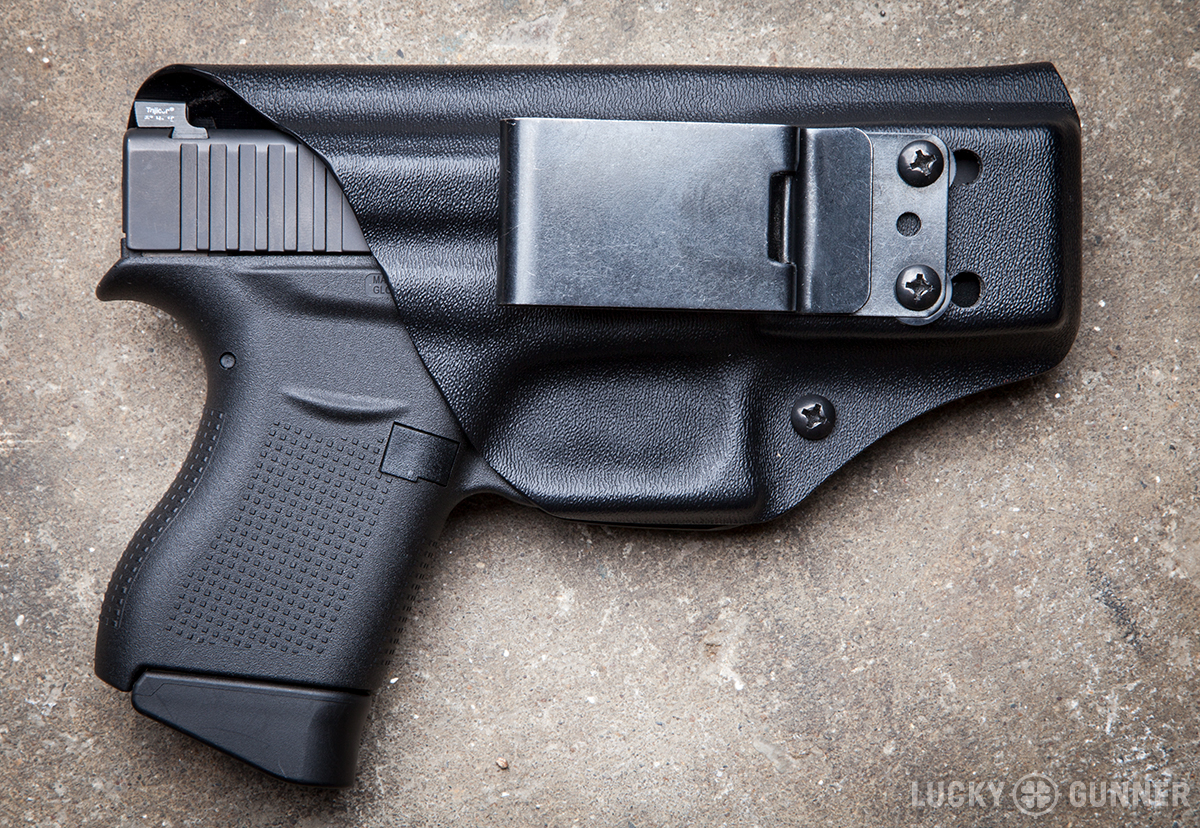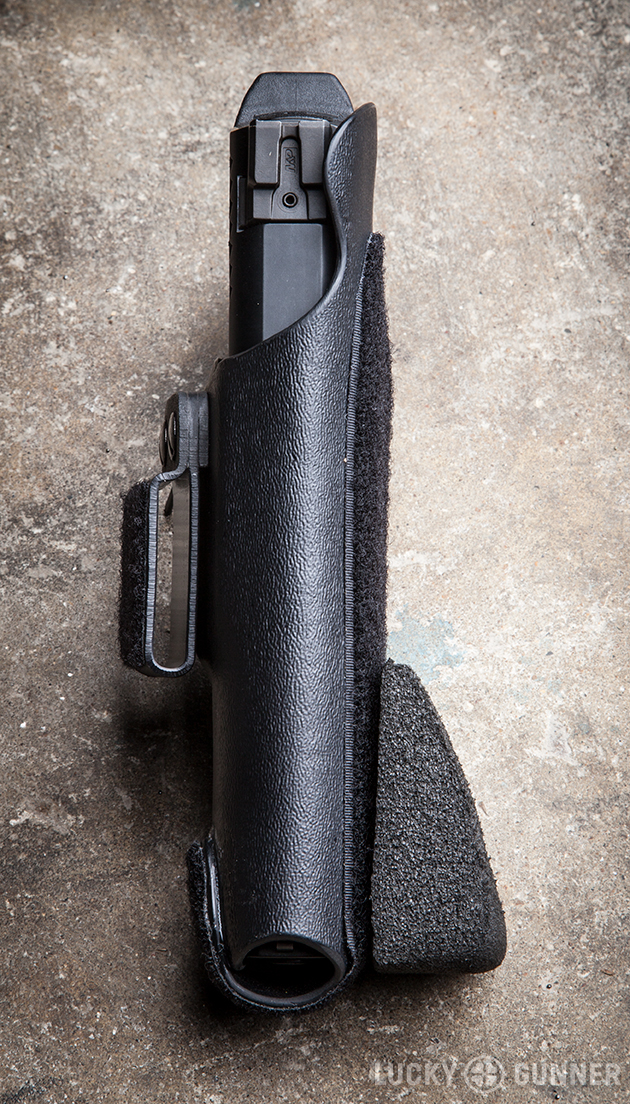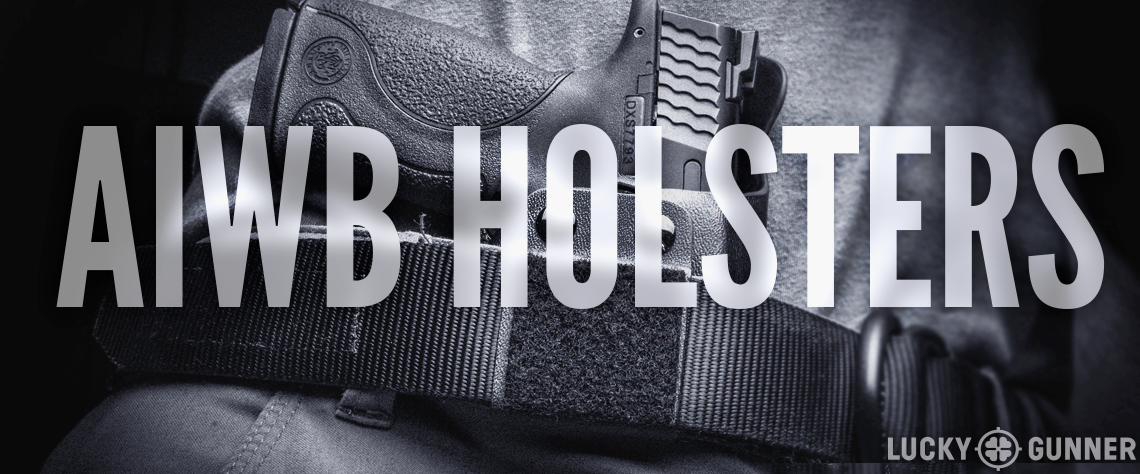There’s a craze sweeping the concealed carry community. Some have even dared to call it a new practice. Others have tried to pass it off as a fad. Many try to decry it, but with a slew of well-known instructors advocating it, I think its here to stay. We’re talking about Appendix Carry.
Appendix carry (sometimes more aptly referred to as “centerline carry” and abbreviated AIWB for Appendix Inside the Waistband) is the practice of carrying a firearm forward of the hip bones and slightly off-center of the belly button. For right-handed shooters, that usually places the firearm at the appendix, hence the name. For lefties, well, we ignore the fact that you aren’t actually carrying in front of your appendix, or we try to include you by calling it centerline.
Appendix carry is not new. It’s been around since people started carrying guns. Somehow, it found its way out of vogue in the 80s and 90s only to reemerge in the late 00s. It continues to surge in popularity today.
Some claim the position is unsafe, but no matter your thoughts or opinions on it, you cannot deny that more and more people are carrying AIWB every day. This isn’t an article about the pros and cons of AIWB. There are a plethora of them out there for those of you that are interested. What I want to talk about here are holsters for AIWB.
Because of the rise in popularity of AIWB, we’ve also seen a surge in holster manufacturers offering AIWB holsters. For the most part, this is a positive thing. A good holster maker is one who sees a demand and tries to fill it with a quality product. That being said, even within the holster-making community, there is a lot of misunderstanding about the position, how it is done safely, and what maximizes the position for comfort and concealment.
As the demand for AIWB holsters has increased, so has the number of standard behind-the-hip holster designs that are being marketed for appendix carry by simply adding an “A” to the description. This is a true disservice to customers as behind-the-hip holsters fill their purposes rearward of the hip bones and are not really made for any other place on a body. Most, if not all, behind-the-hip holsters should not double as AIWB holsters. It could have disastrous results.
The front of the human body requires a different cant for the firearm, there are different challenges for concealment, and comfort can be a big problem for people who decide to give the AIWB position a try. Without a purpose-built AIWB holster, the consumer is looking at an awkward draw stroke, a gun that locks up in the holster on the draw, poor concealment, and discomfort.
To help consumers understand what they are looking for in a purpose-built AIWB holster, and to help weed out the AIWB knockoffs, here are three main features you should look for when shopping for an appendix holster.
Of course, there may be many holsters that do not fit within the following criteria that work marvelously for some people. If you carry safely and effectively in a holster that is different, then I commend you! Keep doing what you’re doing. If you are struggling to find one that works for you, give these tips a try.
Cant
For an appendix holster, cant refers to the gun’s tilt to the left or right while remaining flush against the body. The ideal cant allows the shooter’s dominant hand to naturally grip the firearm without contortion or awkwardness as well as allowing a draw stroke that is smooth, without any excess movement or unnatural arm and hand bends. A cant that is too extreme can cause fumbled draws, and can even cause the gun to get “stuck” during the draw with certain holsters that have built-in retention features.
Holsters carried behind the hip commonly have what is referred to as an “FBI cant”–a slight 10-15 degree forward lean that is natural for the hand to grip when trying to grasp a gun carried behind the hip. An AIWB holster should have a vertical or neutral cant, if not a slight lean a degree or two toward the shooter’s dominant side, to allow the muzzle to clear the thigh. This allows the firearm to be drawn straight up from the holster and keeps the shooter from having to draw the gun across the belly. It eliminates excess movement and makes for a safer, more efficient draw-stroke.

Tuck
No matter how blocky you may be, the abdomen of an average human is fairly oval in shape. Some people are more round than others and, since firearms are rather L-shaped and straight in nature, sometimes the butt of the gun likes to stick out when carried in the appendix position.
A purpose-built AIWB holster addresses this issue with some sort of a built-in tuck feature that purposefully tucks the grip into the belly horizontally. Some holsters do this with the addition of wedges beneath the waistband that angle the grip. Others use wings, claws, or offset loops. The innovation is endless. These features are almost universally positioned where the holster mounts to the waistband around the trigger guard area. They often get their tuck from utilizing the waistband itself and can be vital in tucking the grip away for superior concealment.
Wedge
Even with the tuck, concealment can still be an issue if the gun’s grip falls away from the body. While some bellies are more apt to push grips away than others, the fact remains that the concave slant of the groin, as well as clothing, tend to pull the muzzle downward, pushing the grip outward and compromising concealment. This issue is largely mitigated with a wedge placed somewhere near the muzzle-end of the holster that counters the natural outward angling of the grip.
Depending on your size and shape, you may not need a wedge at all. Or, you might need quite a lot of wedge. Some holsters come with built-in wedges. Others allow for user customization via pads or add-ons. If you find the grip of your gun slipping out, a strong, muzzle-end wedge may be exactly what you need.

One more thing. If you ever plan on taking your holster to a class or any environment where you will be holstering a gun you have recently shot, a holster that protects the entire muzzle of the gun is a good idea. Nothing quite feels like a hot muzzle on the soft tissue of your upper thigh or groin.
Cant, tuck, and wedge (dubbed roll, yaw, and pitch by the late Todd Louis Green) can make all the difference between a good holster that is comfortable and concealable and something that leaves much to be desired. If you have ever wanted to try AIWB, look for a purpose-built holster. You’ll be glad you did.


With my gut concealed carry is out.
Some body shapes can make concealed carry more of a challenge than others, but at every defensive pistol class and training event I’ve attended, there has been no shortage of ample waistbands. Men and women of all sizes and shapes have been able to find comfortable and effective ways to conceal a handgun, including appendix carry for men with guts. If you really want to carry, you can find a way to make it work.
The Remora “no clip” works for appendix carry for me.
I have several Remora’s – and recommend.
I agree. Stays snug and remains in place when the firearm is drawn. No clips, no stiff Kydex, no “holster specific” belts. Works great with my Bodyguard .380, Sig 938 and S&W 442.
Chris, can you make some AIWB holster manufacturer recommendations? I see Keeper’s Concealment above; are there others you’d recommend?
I also like JM Custom Kydex, Dark Star Gear, and Custom Carry Concepts.
I like Vedder’s Light Tuck.
I highly recommend the following for AIWB — I have one from each of these, and they are all great. In no particular order: 1) StealthGear USA AIWB (probably the most “comfortable”), 2) Dale Fricke’s Archangel holster (can add on both the Butt Tuck Adapter – tucks the grip into you, and the Extra Girth Adapter – same as the “wedge” mentioned above, and 3) T.Rex arms Sidecar holster – slimline holster that tucks the grip into you with their Raptor Claw and provides a built in spare mag holder.
hey looking for guns i sell in dark market contact me all you need to do
is download wickr on apps store and contact me via lucho47
they dont make aiwb holsters, how much you getting paid to advertise for them?